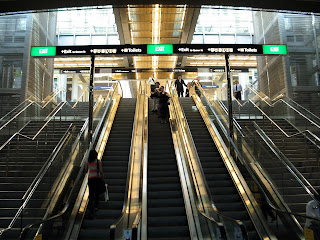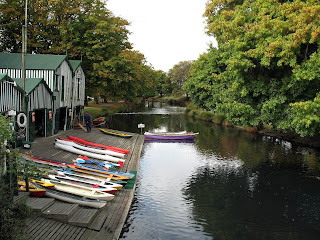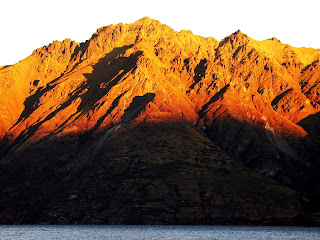Another photography post, I'm afraid.
It's 2021, it's springtime, I have holidays coming up, and my loyal and faithful Leica D-Lux 4 will be twelve years old in June. And it was probably designed fourteen years ago. It's now an old camera. Certainly very old tech.
I rejoice that it remains fully-functional, and indeed looks remarkably little blemished for its age, but I can't help feeling that it's starting to wing it. It must be on borrowed time. It could become dead metal at any moment, without warning, and with no possibility of a viable repair. Not that I'd be eager to send it away for an operation that might not turn out well. Cameras are like car engines. Or indeed human beings. Once opened up, and tinkered with, they may go back together but they are never quite the same. It's not the expense, but the knowledge that the poor thing has been meddled with and its integrity lost. This is not something you do to an old and well-loved friend and companion. When the little Leica dies, I will let it slip away peacefully, shed a tear or two, and look for a sensible modern replacement. (I really mean an amazing and impressive modern replacement, fit for a lady who shoots up to 20,000 a year, depending on the particular holiday destinations and the events of her home life)
The little Leica is anyway long overdue for an honourable and well-deserved retirement. It needs leisure, a long cruise in the sun, an easy time. But I'm still having to flog it unmercifully. Weary it may be, but I am forced to demand more and more from it. The camera on Prudence, the new smartphone bought in January, is certainly capable, with for instance a zoom that the camera on the previous phone, Tigerlily, didn't possess. But it isn't to my taste. I don't like the interface nor the results. Prudence's camera is fine as a decent standby, should the little Leica suddenly emit a death-rattle and expire. Prudence's camera will amply fill the hiatus between the little Leica's tragic demise and the big hello I'll give to its Sensational Replacement. The just-mentioned Sensational Replacement will prompt an absolute orgy of picture-taking. During that orgy the smartphone's camera had best creep off somewhere and hide.
Do I have a replacement in mind? So that I could buy it and start using it in one fluid motion?
The answer is yes, sort of. I do have a shortlist. But there are no clear and obvious successors on it for the little Leica D-Lux 4. I've looked closely (in rising order of cost) at the Ricoh GR III, the Fujifilm X100V, the Leica CL, and the Leica Q2. The outlay (including essential accessories such as an extra battery, handgrip, wrist strap, fast charger and protective carrying bag) varies from £900 odd for the GR III through to £5,000 odd for the Q2. My sweet spot for spending is 'between £1,000 and £2,000'. But that's still an awful lot of money. Enough to make me hesitate and prevaricate. Particularly when I want some other things, such as a new kitchen cooker (with new pans to go with it). And in the background, the cost of an electric car in 2025 or 2026.
A new camera is affordable right now - with extra lockdown savings, I do have the cash, and I don't need any finance - but I must keep in mind that treating myself to a new shooter might put having that new car back by months - maybe a whole year.
Still, if the little D-Lux 4 goes limp in my hands and croaks its last, I will have to spend that money at once and take the consequences. Similarly, if my venerable friend soldiers on into 2022, it will then seem appropriate to buy myself a replacement camera as a 70th birthday present. And, of course, such a present would have to be rather special - meaning expensive! (Although very likely less than the cost of a blockbuster holiday)
The Fujifilm X100V is the camera in my 'sweet spot', and having studied many reviews and video eulogies, I can see why street photographers (its prime target user) tend to rave about it. But for me there are snags to come to terms with.
A small one first. It has a fixed lens with a single focal length. It can't be changed for a different lens, but it is nevertheless a very good lens - reasonably versatile, and suitable for many of the shots I might take. But not all. It will focus down to 10cm, which it pretty close to the subject. But that's nothing compared to how close my little Leica D-Lux 4 can get in macro mode: 1cm. I have to ask myself whether the X100V could really take shots like these, effortlessly captured on the little Leica (click on any of these shots to study them in their full glory):
The X100V has a 26 megapixel sensor, which produces big photo files, whereas the little Leica has only 10 megapixels to call on. So maybe I could take similar shots with the X100V by being a bit further away, but cropping into the photo in post-processing, using just the centre part of the picture and simulating what the Leica had taken. Maybe. I don't think it would quite look the same. But it might be close enough.
What about colours? And black-and white? The Leica's colour and B&W rendition is - to my eye - very natural, but with pleasant richness and contrast. As in these shots, taken on the beach at Kingston Gorse two days ago.
The Fuji's range of preset colours, which mimic the effects of the various old Fuji films, seem muted to me. I'd want something with more pop. Perhaps I can create a custom colour profile that gives me the results I'm used to with the little Leica?
Then there's the question of image-stabilisation, an in-camera method of counteracting hand-shake, so that sharp pictures can be taken at quite slow shutter speeds. This is important for getting crisp pictures in poor light. The little Leica has image-stabilisation, and it's very effective. The Fujifilm X100V has no stabilisation. What it has instead is a sensor that allows higher shutter speeds for a given level of light, and a decently high shutter speed will freeze the scene sufficiently to mask any shake. That might be OK.
But the main potential snag is the focal length of the lens: which is (in full-frame terms) 35mm. So it has a semi-wideangle lens. This is usually regarded as ideal, if wanting to shoot scenes in the confines of a city street, particularly anything involving people. Not so suitable for capturing the vastness of an open sky at sunset, for which the little Leica's lens - 24mm at its widest - is much more effective. The X100V wouldn't be able to take these pictures from two days ago, this time at Ferring:


This is in fact the main question I've been asking myself: whatever the strengths and benefits of the X100V, however good it looks and handles, can I take the pictures I want with just that 35mm lens? Because in the end, it's the pictures that matter. The camera may be a sophisticated object of desire in itself, and an inspirational tool; but what counts is what it can actually do for the particular photographer. For example, people often appear in my pictures, but they are not my prime subject. A camera mostly suitable for portraiture or model work would be limiting for me.
To assess whether the X100V and its 35mm lens might turn out well, I first needed to study my own past pictures taken with a 35mm lens - or with a zoom lens set at 35mm.
As it happens, I owned a Canon G6 from 2005 to 2007, and that was used mostly at 35mm. In fact, all the photos on my two-month trip to New Zealand in 2007 were taken with this camera. I had a good mix of city and landscape shots to study.
City shots first.
I took thousands of pictures in New Zealand. I went everywhere. I feel reassured, looking at shots like the ones above, that a 35mm lens on a high-grade camera would be very suitable for capturing the sights of a city. Some shots are a bit tight; the Leica's 24mm would have been better. And of course, the Canon's 7 megapixels would be easily trumped by a much larger modern sensor. But in the main, it's clear that the X100V, with its 35mm lens, would more than do the job. It would exactly duplicate these shots, but with more detail, or sharper detail, to see in them.
But how useful is 35mm out of town? Back to New Zealand.
Once again, a 35mm lens has done an adequate job. If anything, I'd say the out-of-town shots were more successful than the city shots, which seems rather odd. But then, I would have had more space to move myself into the very best position for the picture. No cars to dodge on these empty beaches!
There are, however, no vast skies here: I know full well that the lens has captured only part of the whole scene. Still, concentrating on a few elements, and seeing less of the entire panorama, isn't necessarily a bad thing.
And so to Brighton in 2021. All very well to study what I did back in 2007. I'd forgotten what the practical issues were when limiting myself to one focal length, and having to compose my shots accordingly. Would I feel frustrated, not being able to get everything I wanted into the shot?
First, I set the little Leica up. It has a zoom lens which, in full-frame terms, goes from 24mm to 60mm. I can't accurately select '35mm', but the scale that momentarily pops up in the screen when zooming gives a pretty good indication of what the focal length is. By default it starts at 24mm when I switch on, and the screen shows this:
The black part of the scale is the normal optical zoom range, 24mm to 60mm. All I have to do is zoom one third of the way along, and that will be about 35mm. Thus:
I can then use a feature called 'lens resume' to fix that focal length, so that every time I switch on the camera, it will go straight there. In that way I turned the Leica into a camera that would only shoot at 35mm. Just for the afternoon's walkabout in central Brighton.
Then, for the next two hours, I wandered about, taking pictures of subjects that would test the viability of shooting only at 35mm. I will just show a short selection of the most striking shots. Being Brighton, they have an edgy, slightly sleazy feel to them. It's not my favourite place. But it is an eminently good location for the kind of shot I wanted.

























I also tried three 'walk-by' shots, with the Leica aimed in the right direction, but down by my side, so that I couldn't be sure of framing or focus. None of the three were sharp, and they all had to be corrected for tilt, but they did capture aspects of the Brighton scene.
Well, I'm encouraged. If the dear little Leica did take the last train to the coast, and the Fujifilm X100V, with its 35mm lens, was the only half-suitable replacement that I could justify buying, then clearly I need not despair. I could find plenty of good uses for that lens.
Of course, if the little Leica, still very much alive and kicking, can turn out pictures like these, it begs the question Why Think Of Changing Sooner Than I Need To? What would I gain, apart from slightly crisper shots*, and perhaps a slightly more impressive-looking camera to tote around? That's what I shall now mull over.
* Slightly crisper shots? Actually, I've yet to see test or sample X100V shots on the Internet that really show significantly better sharpness than the little Leica can deliver. I'm not seeing the crispness and 'bite' I'd hope for.
Perhaps it would be there if I kept to f/5.6, and upped the ISO to compensate where needed, which would also improve the shallow depth of field so that more of the picture is in good focus. A shallow depth of field ensures that the subject of chief interest will appear especially sharp and distinct, because the foreground and background will be in softer focus, or else completely blurred. This is a very good technique for emphasising the main subject, so that it, or he, or she, stands out distinctly. In addition, many 'proper photographers' pay great attention to the quality of the out-of-focus background, and may drool over what they term a good 'bokeh' - meaning a creamy or at least pleasantly unobtrusive rendering that doesn't make the picture look unbearably busy. The X100V can provide this in spades. So kudos to the camera, in that respect.
I'm not averse to an attractive but indistinct background when I want it, but mostly I don't. Usually I prefer everything in the picture to be at least moderately sharp. I want to to see all the details, with the main subject shown in context, in a recognisable setting, the surroundings being for my purposes an equally important part of the picture. The peripheral detail captured in many of my older shots can indeed be most interesting - given the accelerating pace of change, things become 'historic' and therefore fascinating only twenty years later! But blurring such detail obscures the information in the picture, and reduces its long-term documentary value.
It may be that the published X100V shots that I've seen were expressly taken to avoid having everything in sharp focus, and to demonstrate the particular pictorial effects the X100V can produce. Even so, close-ups of things like bubbles in cool drinks - taken indoors at full aperture, with an almost non-existent depth of field - don't reassure me that the X100V can handle macro work at all well, although I do realise it wasn't designed for that. Street scenes, cityscapes and seafronts are generally in reasonably good focus, and I have seen some pictures, taken in good light, that have impressed me with the wealth of clear detail contained in them.
But I'm still not seeing anything that blows me away and makes me think:
'Wow! I'm definitely missing out! It's time to buy an X100V and discard the little Leica!'
Or indeed:
'Look! John Lewis have a black X100V in stock online! I'll buy this NOW and get it click-and-collect tomorrow at Waitrose.' (As I write this, they actually do have one...)
I really wish I could say these things, but I can't. My old friend remains too versatile, too useful, too reliable and consistent, and just gives me exactly what I'm looking for in a small camera. The 83,400 pictures I've taken with it are evidence enough that it's a joy to use, and will be very difficult to replace.
Despite the words above, I think I would probably turn to the X100V if the little Leica packed in. I'm pretty sure I could change my style, learn to exploit the Fuji's strengths, and (like many others) fall in love with it. But as it is - with the Leica still feisty and capable, very much alive, and yielding pictures I'm proud of - I'd make damaging comparisons between the old and new cameras, and end up reverting to the Leica simply because it was the simpler, smaller, lighter, and more discreet walkabout companion.
It's happened before, when I've attempted to upgrade. It just wastes a lot of money.




























































































